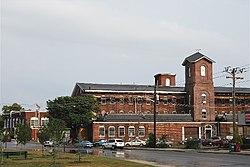
The Slater Mill is a historic textile mill complex on the banks of the Blackstone River in Pawtucket, Rhode Island, modeled after cotton spinning mills first established in England. It is the first water-powered cotton spinning mill in North America to utilize the Arkwright system of cotton spinning as developed by Richard Arkwright.

The Hanora Mills are a historic textile mill complex at the junction of Bernon and Main Streets in the center of Woonsocket, Rhode Island.

The Woonsocket Company Mill Complex is a historic district encompassing one of the largest mill complexes in Woonsocket, Rhode Island. The district includes all of the buildings historically associated with the Woonsocket Company, a major manufacturer of cotton textiles in the 19th century. The complex is located along the eastern bank of the Blackstone River between Court and Bernon Streets. It includes three handsome stone mills, built between 1827 and 1859, and a power plant that was built on the site of the former #3 mill between 1890 and 1920, as well as the remnants of the canal that originally carried water to the buildings for power.

The Valley Falls Mill is a historic textile mill complex on Broad Street in Central Falls, Rhode Island. The complex consists of the primary mill building, a large Italianate brick four-story building erected in 1849, several outbuildings. a dam across the Blackstone River, and a portion of the original canal system which provided water power to the mill. The outbuildings include the gatehouse controlling waterflow into the canals, a small stuccoed office building now serving as a retail establishment, and a brick bathhouse built c. 1870 that stands just south of the mill race. The complex originally had a second mill building and power canal; that building was destroyed by fire, and its canal was filled in. The main mill building was developed as housing in the late 1970s, including a sympathetic replacement for the second mill building.

The Dyerville Mill is an historic textile mill complex at 610 Manton Avenue in Providence, Rhode Island, USA. Its oldest buildings dating to 1835, it is one the oldest textile mill in the city. The complex is located between Manton Avenue and the Woonasquatucket River, just south of the Dyerville Mill Pond. Remnants of the head race run south from the pond, through the property, with the tail race exiting to the southwest. The main mill building is a 3-1/2 story L-shaped stuccoed stone structure. The picker house is a 2-1/2 story stone structure southwest of the main mill, with a brick extension that also gives it an L shape and creates a courtyard with the main building. A 20th-century warehouse stands south of this complex. The mill was established by Elisha Dyer, father of Elisha Dyer and grandfather of Elisha Dyer, Jr., and was operated by the Dyer family until 1867. It was then operated by cotton broker Truman Beckwith and his son. The Joslin Manufacturing Company purchased the business in 1903 and operated textile production on the site until the 1930s. The site has thereafter seen other light industrial uses.
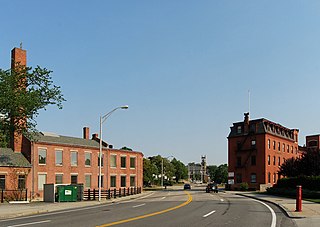
Moshassuck Square is an industrial historic district in Providence, Rhode Island, lining the banks of the Blackstone Canal just north of the Rhode Island State House. It consists of the few surviving buildings of the once-extensive American Screw Company complex, which was largely developed between the 1840s and 1870s, and was a major fixture in the Providence landscape prior to its destruction by fire in 1971. The buildings are in an area bounded by Charles Street on the west, Stevens and Hewes Streets on the north, North Main Street to the east, and Mill Street to the south. Prominent among them are the Stillman White Foundry and Fletcher Manufacturing Company office building, which stand on opposite sides of Mill Street near its crossing of the canal. At 127 Charles Street stands a three-story brick building built c. 1900 as a retail and residential building. The only surviving elements of the Screw Company complex are located at North Main and Hewes Streets, and now house the Providence Center.

The Rising Sun Mill, formerly the National and Providence Worsted Mills, are a historic textile mill complex located at 166 Valley Street in Providence, Rhode Island. The complex consists of thirteen brick and stone structures, ranging in height from one to four stories, located on the banks of the Woonasquatucket River in the Olneyville neighborhood of the city. Most of them were built between 1880 and 1890, with a small number from 1907 and later. The National and Providence Company and its successors operated here from 1881 into the 1950s, a time period when Providence was a leading manufacturer of worsted wool material.
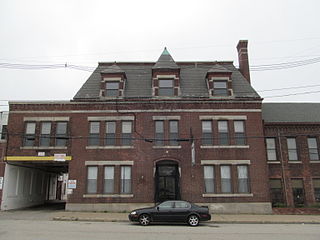
The Nicholson File Company Mill Complex is a historic industrial manufacturing complex at 1-45 Acorn Street in Providence, Rhode Island. It consists of 24 buildings occupying 7 acres (2.8 ha) of land, of which 20 are historically significant. The oldest of the buildings were built in 1865 to designs by William Nicholson, and the complex was regularly expanded over the decades through the early 20th century. The Nicholson File Company was a major producer of machine-made files, started by William Nicholson in 1859. The company manufactured precision tools used in the manufacture of armaments during the American Civil War for the Union Army, and closed the plant in 1959. It has been used by a variety of light industrial concerns since then.

The Upper Rockville Mill is an historic mill complex at 332 Canonchet Road in Hopkinton, Rhode Island. The complex occupies about 0.5 acres (0.20 ha) of land, and includes two buildings, the site of a third, and their associated waterworks, including Wincheck Pond and surviving raceway elements. The two buildings are the main mill building, a 3-1/2 story stone structure built 1844-45, and a two-story auxiliary building added in the 1860s. The Rockville Manufacturing Company, which operated the mill, was a major employer and landowner in the area for much of the 19th century. The property was operated by a variety of textile concerns until 1953, when the property was briefly owned by the Boy Scouts of America (BSA), whose Camp Yawgoog, located on the shores of Wincheck and Yawgoog Ponds, was affected by the mill's water rights. The BSA retained the water rights and sold off the rest of the property.

The Crompton Mill Historic District is a historic district encompassing a mill complex at 20 Remington Street, 53 and 65 Manchester Street in West Warwick, Rhode Island. The mill complex consists of a collection of mainly brick buildings, bounded by the Pawtuxet River and Pulaski, Remington, and Manchester Streets in the village of Crompton. The mill complex formerly extended across the river, but the complex on the west bank was destroyed by fire in 1992. The oldest elements of the complex are the dam site and some of the raceways that provided water power to the mills. The present dam was built in 1908, replacing an 1882 structure. The raceways were built in 1807, around the time of the first mill buildings. The stone Mill No. 1, built 1807, is believed to be the oldest stone mill building in the state. Most of the complex's buildings were built in the late 19th and early 20th centuries by the Providence Manufacturing Company and its successors. The mill was used for textile processing until 1946, when the Crompton Corporation ended production.
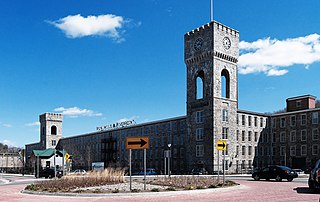
The Royal Mill Complex is an historic textile mill site at 125 Providence Street in West Warwick, Rhode Island. The mill complex was listed on the National Register of Historic Places in 2004. It has recently been completely renovated and remodeled into 250 residential apartments. The complex also includes the Ace Dye Works mill on the south side of the river, which has been converted into lofts. A pedestrian skybridge connects the two mills.

The Valley Queen Mill is an historic mill at 700 Providence Street in West Warwick, Rhode Island.

The Jules Desurmont Worsted Company Mill is a historic mill at 84 Fairmount Street in Woonsocket, Rhode Island. The mill complex consists of three brick buildings, erected 1907-10 by Jules Desurmont, the owner of a textile firm in Tourcoing, a city in northern France, who had been drawn to Woonsocket by the promotional activities of Aram Pothier. The mill produced French worsted wool yarn until 1952, and was used for many years thereafter by smaller textile and industrial concerns.
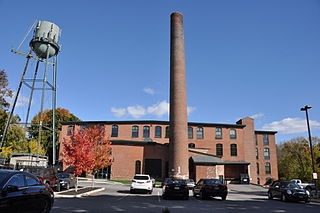
The Pocasset Worsted Company Mill is an historic industrial complex at 75 Pocasset Street in Johnston, Rhode Island. It consists of a complex of four connected brick buildings, built between 1897 and 1902. The buildings form a rough U shape on a 3.38 acres (1.37 ha) parcel of land between Pocasset Street and the Pocasset River. The two legs of the U are nearly identical main mill buildings, constructed in 1897 and 1902; they are joined by an engine and boiler house. The mill office building is attached to the southern (1897) mill building. The Pocasset Worsted Company was Johnston's largest employer in the early 20th century; its buildings were used for textile production until 1989.
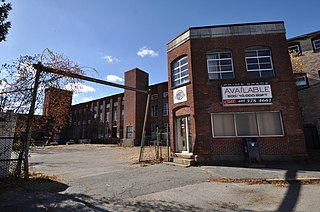
The Lymansville Company Mill is a historic industrial complex at 184 Woonasquatucket Avenue in North Providence, Rhode Island. The oldest portion of the complex, a three-story brick building which originally a textile spinning and carding building, was built in 1884. The mill was significantly expanded in subsequent years, with its last addition taking place in 1951. The Lymansville Company was founded in 1884 and closed in 1957. Auguste Albert Sack, the leading partner in the company, was a German immigrant with significant work experience in New England's textile industry.
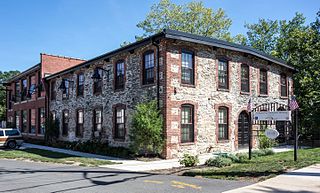
The Heaton and Cowing Mill is a historic industrial facility at 1115 Douglas Avenue in Providence, Rhode Island. The small mill complex consists of three connected building sections; the oldest is a c. 1832 rubble-walled two story mill building constructed by David Heaton and Martin Cowing on the banks of the West River. The partners used the facility to manufacture and dye cotton cloth. The building is the remnant of a much larger Geneva Worsted Company works that Heaton and Cowing built on the site in the 1860s and 1870s. The building was used, with a major brick addition c. 1930, for textile production until the 1950s, until its last textile owner, the Wanskuck Mill, shut down. It served a variety of light industrial businesses, and in 1982 a concrete block building was added to its rear. Most of its original waterworks infrastructure has either been filled in, or was destroyed by flooding in 2010.
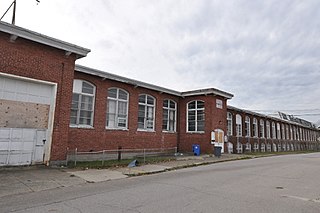
The Naushon Company Plant is a historic textile mill complex at 32 Meeting Street in Cumberland, Rhode Island. First built in 1902-04 and enlarged over time, it illustrates the adaption of the site to differing uses between then and the 1950s, when its use for textile manufacture ended. The complex was listed on the National Register of Historic Places in 1978.

The American Supply Company Building is a historic industrial building at 1364 Broad Street in Central Falls, Rhode Island. Built in 1876, it was home to a prominent regional manufacturer of loom parts supplied to the area's textile manufacturers. The building was listed on the National Register of Historic Places in 2017. As of 2017, it is vacant and owned by the city, which is considering adaptive reuse for the property.

The Rochambeau Worsted Company Mill is a historic textile mill complex at 60 King Street in the Olneyville neighborhood of Providence, Rhode Island. Set between King Street and the Woonasquatucket River, it is a three-story brick-clad steel frame structure, built about 1923. It was the third mill in Rhode Island in which a French system of textile processing was implemented. The business was established in 1922 by the Lepoutre Brothers, French immigrants who had first begun operations at the Lafayette Worsted Company in Woonsocket, and operated until 1956. It was thereafter occupied by the Imperial Knife Company, which operated here until 1987, manufacturing tableware.

The Andrews Mill Company Plant is a historic industrial complex at 761 Great Road in North Smithfield, Rhode Island. Built beginning in 1918, it was home to a maker of French worsted wool textiles, part of a major industrial development push in northern Rhode Island at the time. The complex was listed on the National Register of Historic Places in 2018.
